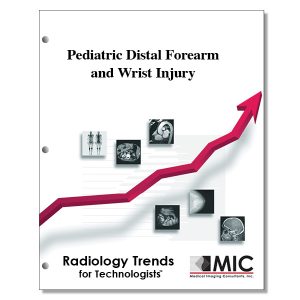

Pediatric Distal Forearm and Wrist Injury
A review of the development and anatomy of the pediatric distal forearm and wrist, as well as a presentation of injury mechanisms and imaging techniques.
Course ID: Q00433 Category: Radiology Trends for Technologists Modalities: MRI, Radiography2.25 |
Satisfaction Guarantee |
$24.00
- Targeted CE
- Outline
- Objectives
Targeted CE per ARRT’s Discipline, Category, and Subcategory classification for enrollments starting after May 25, 2023:
[Note: Discipline-specific Targeted CE credits may be less than the total Category A credits approved for this course.]
Computed Tomography: 2.25
Procedures: 2.25
Head, Spine, and Musculoskeletal: 2.25
Magnetic Resonance Imaging: 2.25
Procedures: 2.25
Musculoskeletal: 2.25
Nuclear Medicine Technology: 1.00
Procedures: 1.00
Other Imaging Procedures: 1.00
Radiography: 2.25
Procedures: 2.25
Extremity Procedures: 2.25
Registered Radiologist Assistant: 2.25
Procedures: 2.25
Musculoskeletal and Endocrine Sections: 2.25
Outline
- Introduction
- Development, Anatomy, and Radiologic-Anatomic Considerations
- Distal Forearm Fractures
- Buckle Fractures
- Greenstick Fractures
- Complete or Displaced Fractures
- Physeal Injuries
- Galeazzi and Galeazzi-equivalent Fractures
- Bone Contusion
- Carpal Fractures
- Scaphoid Fractures
- Other Carpal Bone Fractures
- Carpal Dislocations
- Chronic Overuse Injuries
- Conclusion
Objectives
Upon completion of this course, students will:
- identify what patient demographic has growth plates
- list differences between the pediatric and adult skeleton
- describe the structure of the carpus at birth
- list the order of carpal development
- describe the articulation of the wrist
- recite in order both the proximal and distal rows of carpal bones
- recognize the pisiform as a sesamoid bone
- describe ulnar variance
- list the bones that align longitudinally in a laterally neutral wrist image
- specify the amount of space between the scaphoid and lunate in a mature carpus
- list the four most common distal radius fractures seen in children
- explain where buckle fractures most commonly occur in the pediatric wrist
- list views that are helpful in identifying subtle wrist injuries
- specify the percentage of occurrence of sub-type Salter-Harris fractures
- state radiographic findings that indicate further evaluation of occult type 1 fractures
- describe what portion of the bones is involved in a Salter-Harris type IV fracture
- list the Salter-Harris fracture classification types
- explain where most Salter-Harris type V fractures occur
- note the prevalence of Galeazzi fractures
- specify the number of weeks for a bone contusion to heal
- identify which imaging modality detects bone contusion
- state the most frequently fractured carpal bone in children
- list risk factors for increased chance of multiple scaphoid fractures
- specify the modalities that best demonstrate pediatric lunate injuries
- express which carpal is the last to ossify
- describe how capitate fractures occur
- classify the four stages of lesser arc injuries
- verbalize the key finding on lateral wrist radiographs that helps diagnose carpal dislocation
- describe changes noted in Salter-Harris type 1 fractures of the distal radius
- note factors associated with chronic overuse injuries of the wrist and hand
